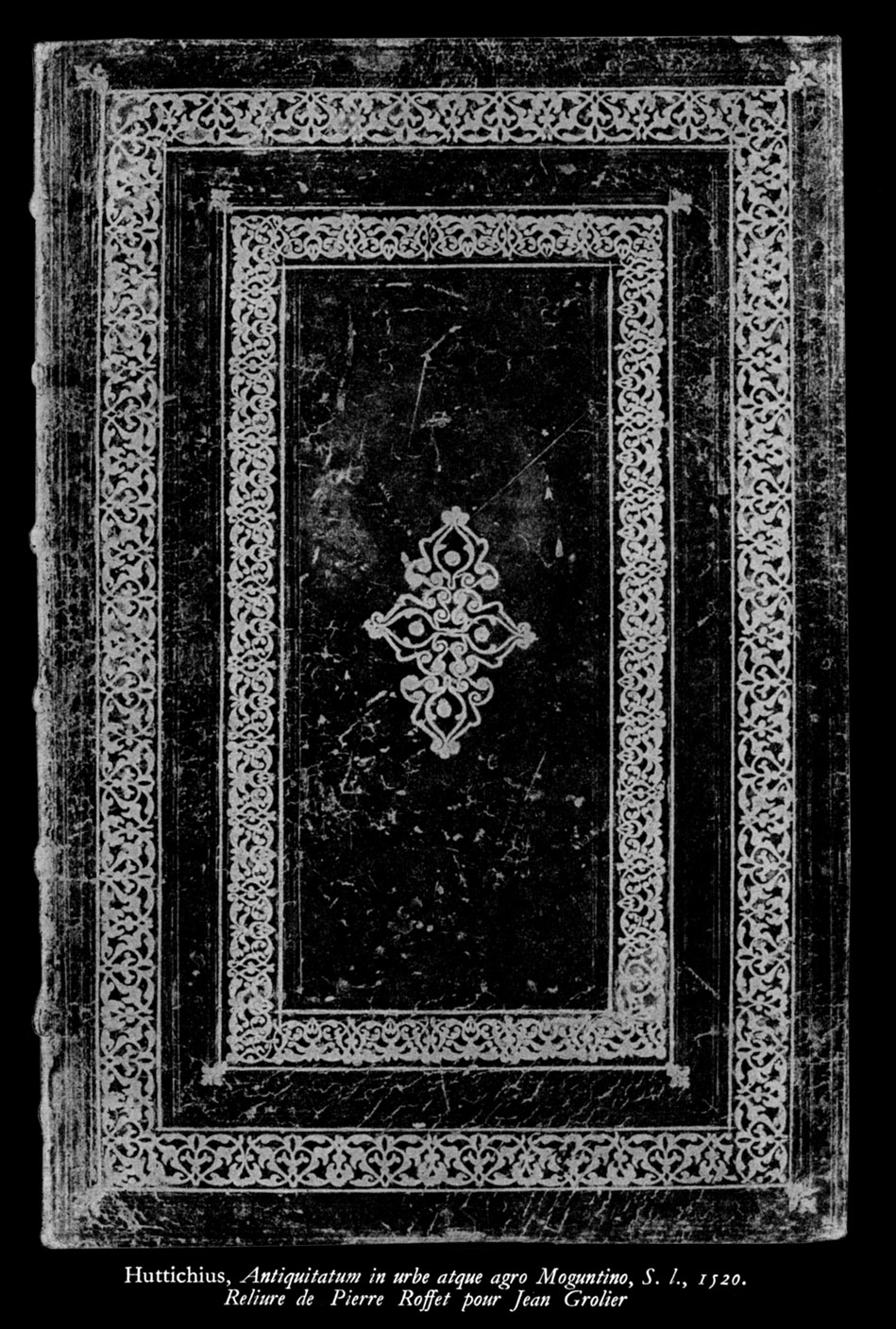

| The next Pierre Roffet binding comes from, Premières reliures parisiennes à décor doré, de l'atelier des reliures Louis XII à l'atelier du Maître d'Estienne, ou de Simon Vostre à Pierre Roffet. by Jacques Guignard, in Humanisme actif : Mélanges d'art et de littérature offerts à Julien Cain. Paris : Hermann, 1968, t. II, p. 229-249. On Plate 15 Guignard presents another Pierre Roffet binding for Grolier, here at last we nearly see the famous Fleur-de-lis fleuron that gave the name to the Fleur-de-lis Binder. I have enlarged the binding to 100 % size at 300 dpi and extracted the fleuron that appears to be the signature fleuron of the Fleur-de-lis binder. The image is not very clear as this is a large foilio sized binding and minimal quality reproduction, however the size and shape indicate that this is very likely to be EF. 18. |
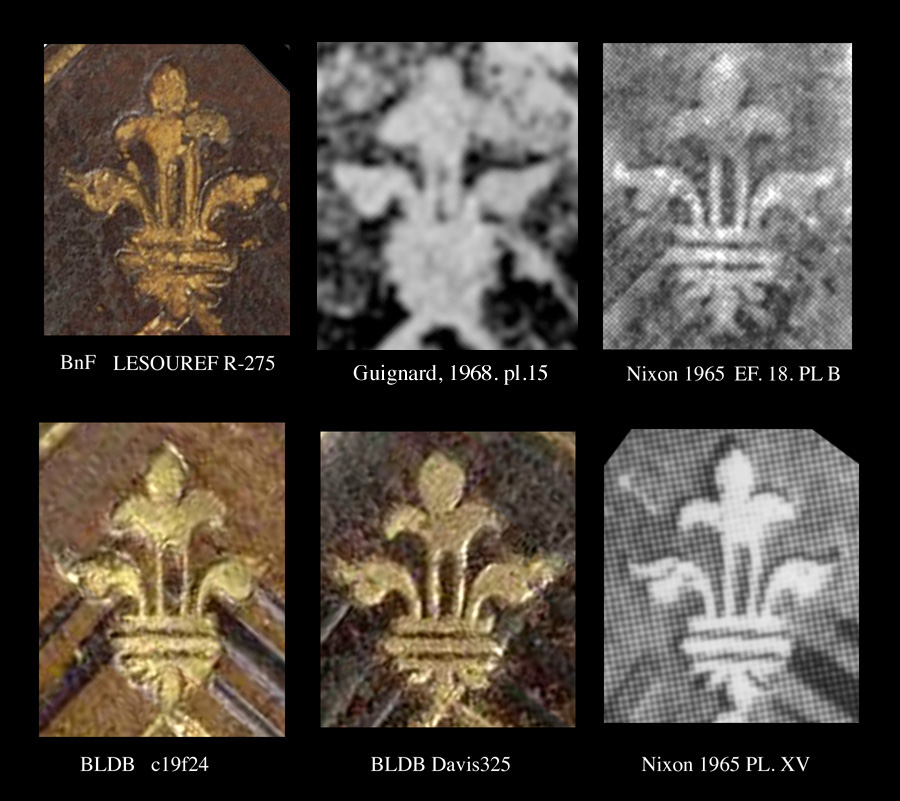
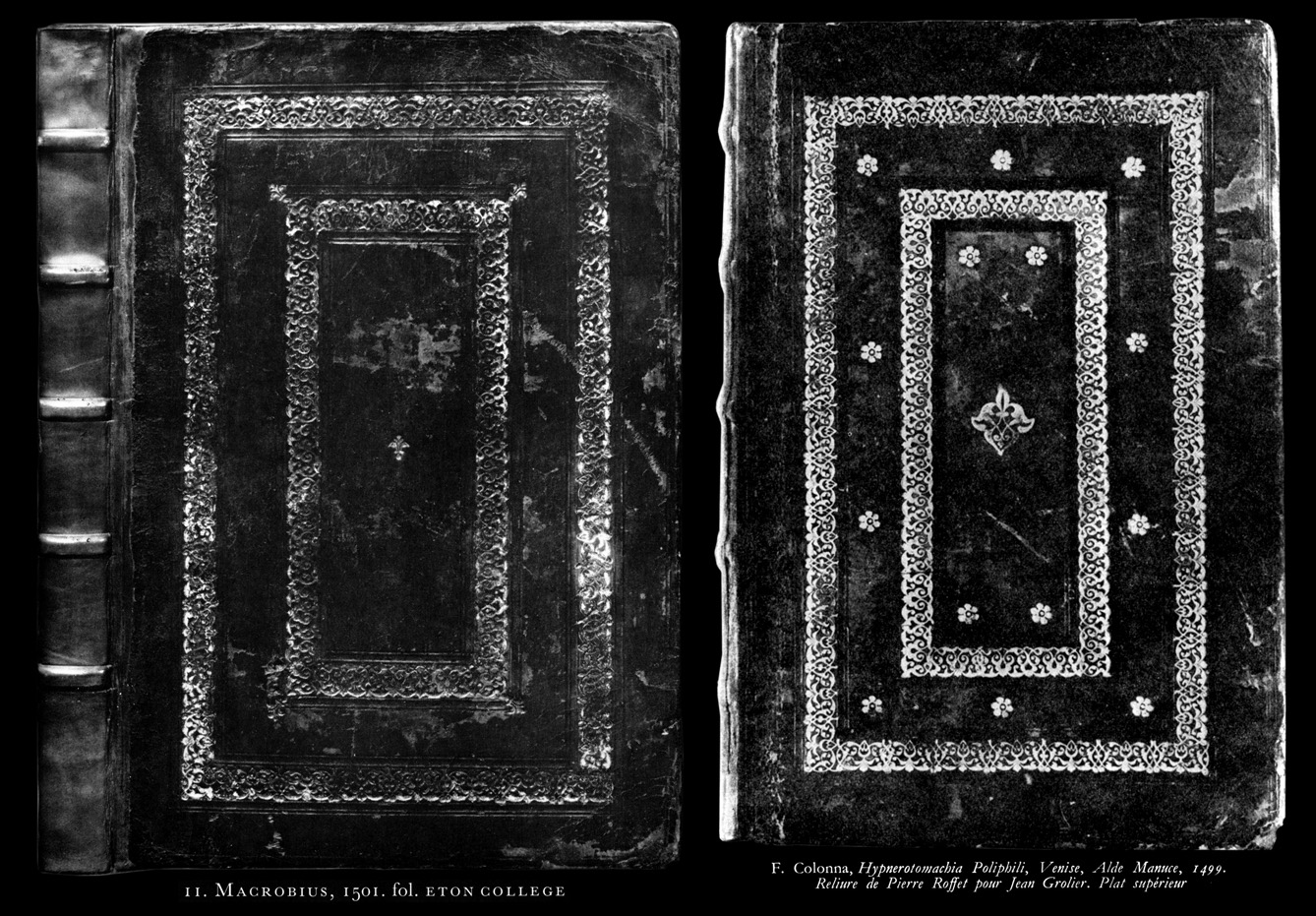
| A more convincing piece of evidence is shown im Comparative Diagram 2, where we compare Nixon's binding 11 with Guignard's plate 12 Pierre Roffet binding for Grolier, both bindings were made for Grolier they both have frames built of EF. 3 and EF. 4 imprints, i.e. identical imprints arranged in an identical design. |
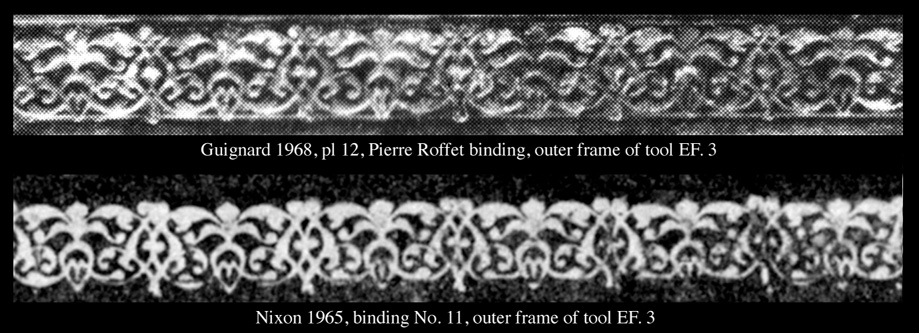
| Guignard goes further in his analysis. Linking the tools of Vostre to Roffet: About a year after the death of Simon Vostre (4 June 1521) his widow Genevieve Le Pelletier also passed away (16 July 1522). Six months later on the 15 January 1523 the surgeon Gilles de Verly, husband of one of Simon Vostre's sisters Marguerite Vostre, sold to Pierre Roffet some of Vostre's material (see the official transcript here) |
|
Vente par Gilles de Verly, chirurgien juré et bourgeois de Paris, à Pierre Roffet, libraire et bourgeois de Paris, des livres, reliés et à relier, du papier blanc, du vélin, des fermoirs, de l'azur, des ais de bois, des platines et de tous les ustensiles se trouvant dans un ouvroir sur rue, devant Sainte-Genevi¸ve-des-Ardents, moyennant 2,650 l. t. 13 janvier 1523 |
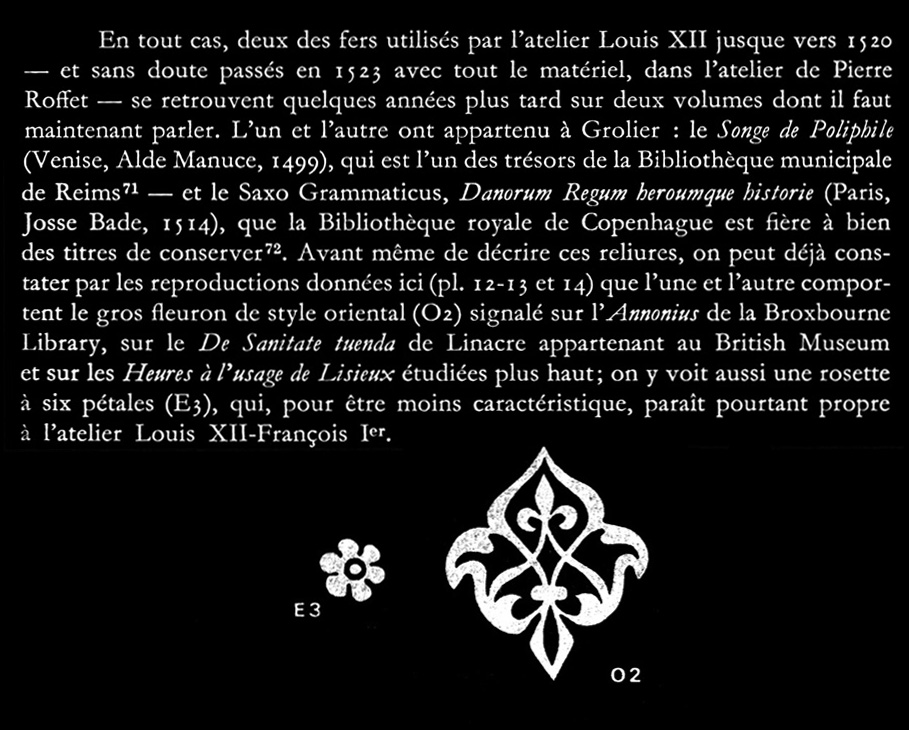
|
It may be possible, given the evidence shown above to state categorically that Pierre Roffet was the Fleur-de-lis binder as defined by Nixon in his 1965 catelogue. However as Pierre Roffet died in 1533 someone must have taken over the work from 1533 (or earlier) to 1538 to produce the bindings that are so familiar as typical for this binder. Many experts point to Etienne Roffet as the most likely candidate for this post, however the issue is far from resolved. If Etienne Roffet executed the Fleur-de-lis bindings for Grolier, why did he have a completely different set of tools for his own work. Some have proposed the Roffet ran a number of different workshops. On the next page we are going to explore in detail what some might call the atelier Louis XII fiasco. It derives from the over zealous work of Jacques Guignard who went to great lengths to promote his theory on the supposed atelier of Simon Vostre. Part of which touches the bindings shown above. and should remind us to be more cautious when attributing bindings to certain binders based on poor quality images. In Comparative Diagram 4, I have reproduced part of Guignards arqument:: "In any case, two of the tools used by the atelier Louis XII, right up to around 1520, and without doubt passed in 1523 with all the material (from the Simon Vostre workshop), into the alelier of Pierre Roffet, where we find them some years later on two volumes , both belonged to Grolier: le songe de Poliphile (Venise, Alde Manuce, 1499), that is one of the treasures of the Bibliotheque municipale de Reims and le Saxo Grammaticus Danorum Requm heroumque historie (Paris, Josse Badde, 1514), a proud possession of the Royal Library of Copenhagen. Before describing these bindings we can study their reproductions shown here (pl. 12-13 and 14) Bindings 12 and 13 are decorated with the large oriental (arabesque) style fleuron (O2) found on l'Annonius of the Broxbourne Library, on the De Sanitate tuenda de Linacre in the British Museum and on the Heures a l'usage de Lisieux studied above we see also a rosette of 6 petals (E3) that appears not so characteristic yet belongs to the atelier of Louis XII-Francois Ier" |
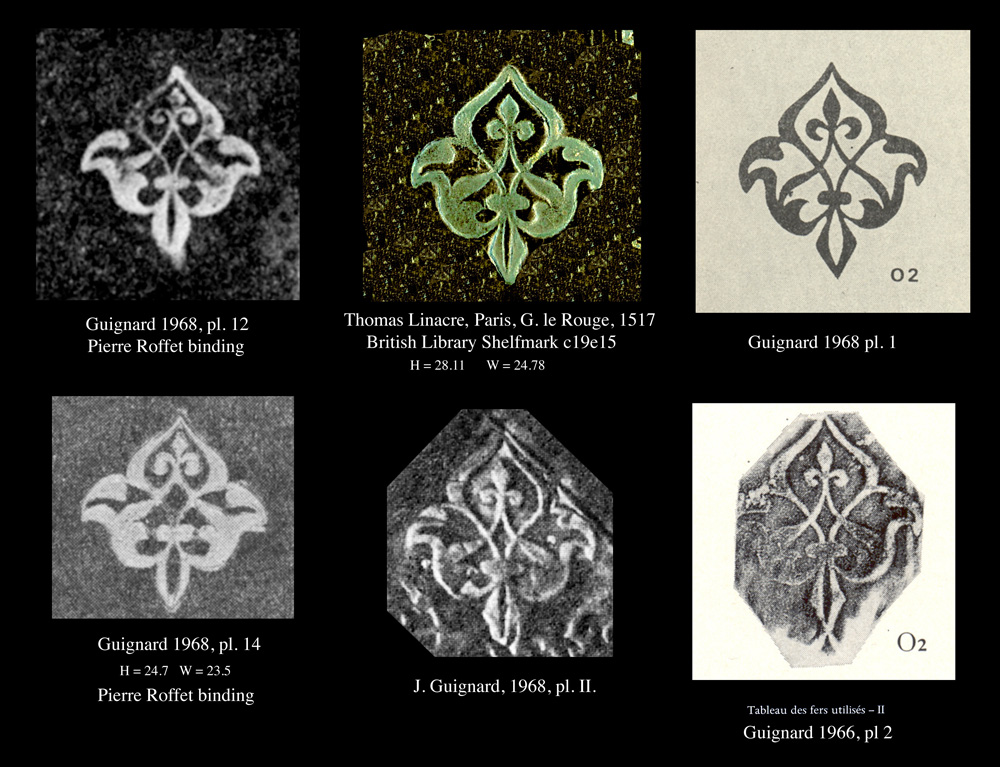
| In Comparative Diagram 5, we can clearly see that the imprints found on the Pierre Roffet bindings are not as Guignard claimed, made by the same tool that left the imprints on the Linacre or Annonius bindings. Guignard needed to show that this tool was found in the Simon Vostre tools purchased by Roffet, thus proving his theory of the atelier of Simon Vostre. However we can clearly see that this is not the same imprint, it is smaller and of a similar but different shape. How could Guignard not have known this? Obviously he tried to fudge this evidence as proof, such dubious methods raise much doubt about the man himself and his theories that have been swallowed hook line and sinker by the BnF. |
| information about the author | return to the home page of VIRTUAL BOOKBINDING |